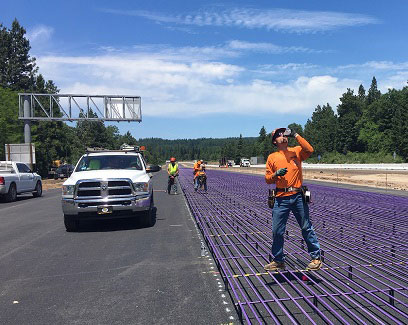Health & Safety
Caltrans Committed to Heat Illness Prevention
By Theresa Drum
Caltrans Maintenance Safety Liaison
and Lupita Franco
District 2 Public Information Officer
With hot weather fully upon us, first-line supervisors have direct responsibility to implement the Department’s Heat Illness Prevention Plan to ensure that it is an effective part of the overall Injury and Illness Prevention Program (IIPP).
Supervisors and employees who work out in the field need to be heat-aware at all times.

A worker drinks to stay hydrated at the Interstate 5 Dunsmuir Grade Project in Siskiyou County (District 2).
It isn’t always feasible to erect shade canopies in our work zones. For this reason, we do have the ability to use an air-conditioned vehicle as shade. A vehicle with the air conditioning operating that has been allowed to cool prior to entering is considered acceptable shade. This means that a vehicle will be idling for the majority of the work shift, and we must comply with California Air Resources Board regulations. The regulation covers heavy duty diesel vehicles with a Gross Vehicle Weight Rating (GVWR) of at least 10,000 pounds.
We do have an exemption to this rule, but it would only apply if the only truck available for use as shade is a heavy-duty diesel vehicle of 10,000 pounds or heavier. The vehicles of choice to use as shade are trucks that meet the low-NOx idling emission standard (clean-idle sticker required), light fleet gasoline powered, then light fleet (under 10,000 pounds) diesel.
Sufficient drinking water also is a critical factor. Supervisors must make arrangements to provide fresh, pure, suitably cool drinking water to employees. The water shall be located as close as practicable to the area where employees are working. Where drinking water is not plumbed or otherwise continuously supplied, it shall be provided in sufficient quantity at the beginning of the work shift to provide one quart per hour, per employee for the entire shift. Enough water to meet this requirement for the planned shift shall be available at all times for each employee who works outdoors in the heat, unless a plan to replenish water during the day is carried out and documented. It is the employee’s responsibility to remain hydrated.
Inland areas present more heat risks, and Redding-based District 2 is no exception. High temperatures in the North State often reach above 100 degrees.
On a recent visit of work sites, a tour of the I-5 Dunsmuir Grade Project in Siskiyou County by D2 staff observed that the contractor’s workers were staying well-hydrated while installing epoxy-cover reinforced steel bars.
Supervisors or designees must ensure that effective communication by voice, observation or electronic means is maintained so that employees at the work site can contact a supervisor or emergency medical services if necessary. A cell phone or text messaging device may be used for this purpose only if reception in the area is reliable. If this is not possible, the supervisor will ensure other means of summoning emergency medical services (e.g., the supervisor designates an employee who can be reached by radio).
Workers also must be provided cool-down rest periods for at least five minutes.
Supervisors are responsible to ensure employees are trained on acclimatization and, when planning work, consider the need to acclimate to anticipated heat conditions. This is of particular importance for new employees, and employees who have not previously worked out in the field.
Formal training shall be provided to all employees before working where environmental risk factors for heat illness are present, and refresher training shall be provided annually.
According to OSHA, the most common heat related problems in hot environments are tired muscles, cramps and heat rash (skin irritation caused by sweat that does not evaporate from the skin.)
Caltrans also deploys safety vans in every district. District safety personnel in partnership with the Divisions of Maintenance and Construction utilize the vehicles as a visual reminder to our employees and to the public that safety is a top priority.
Safety personnel drive the vans, visiting maintenance stations, equipment shops, field locations and community events sharing the Caltrans safety message. Besides the visual message that the vans deliver, the vans are stocked with personal protective equipment that can be distributed to employees who are not wearing the proper safety equipment, including skull caps and baseball caps to help minimize the effects of working in the sun. The vans also serve as a resource for employees to communicate innovative safety ideas, share concerns, and get clarification on proper safety policies and procedures.
- Director's Corner
- Hats Off
- Health & Safety
- News
- Obituaries
- Retirements
- Service Awards
- Who's New

